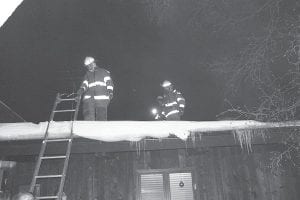Cook County Law Enforcement received a call at 10:37 p.m., Monday, December 30, 2013, reporting a chimney fire at the home of Craig and Lynn Schulte on 8th Avenue in Grand Marais. The Grand Marais Fire Department was paged and was on scene by 10:50 p.m. to find the fire nearly out. Craig Schulte had partially doused the fire with salt.
Firefighters used ladders to get on the roof and put more salt down the chimney. A chain was lowered into the chimney to knock down any remaining creosote, the tar-like flaky substance that caught fire. The fire was completely extinguished and firefighters were clear from the scene by 11:11 p.m.
According to www.TheChimneyDoctor.com, chimneys are well-insulated and it is unlikely that a chimney fire will spread to the rest of the house. However, in rare instances, a chimney fire can catch on explosively, shooting flames and dense smoke out the top or can be slow-burning and barely noticeable until it is hot enough to damage the chimney and catch the house on fire.
The Chimney Doctor offers the following advice:
Unseasoned Firewood
Burning green wood isn’t an easy task. Green wood contains a lot more moisture than seasoned wood, and that moisture has to be removed somehow in order for the wood to burn. The resulting smoke is cooler than if seasoned wood had been used. Cooler smoke is more likely to come out of its gaseous state, condensing and forming creosote on the inside of the chimney.
Cold Temperatures
Cold on the outside of the chimney can also help cool the smoke down to the point where it condenses and forms creosote. If it’s an exterior chimney, running up the side rather than through the center of the house, this adds to the possibility.
Air Supply
It helps to have good currents of air to lift the smoke out of the chimney before it condenses. If the fireplace can’t draw air in freely, this interrupts the flow and, again, creosote forms. Closing the fireplace’s glass doors or not opening the damper all the way are the main ways in which air supply gets restricted.
In addition to all this, remember that large, compact bundles of wood tend to produce cooler fires. Build smaller, hotter fires instead. And don’t burn cardboard boxes or wrapping paper in your fireplace. It’s too easy for a flaming piece of paper to waft up the chimney and catch things on fire.
But most importantly, advises The Chimney Doctor, have your chimney inspected and cleaned regularly. Nothing can completely prevent the creation of creosote. But a certified chimney sweep can keep the problem from getting out of hand.



Leave a Reply